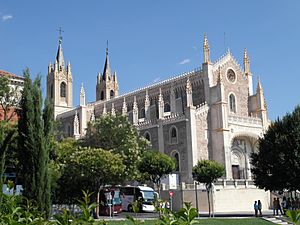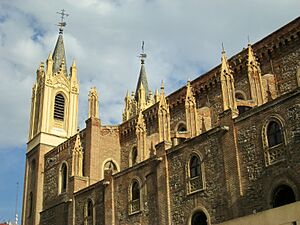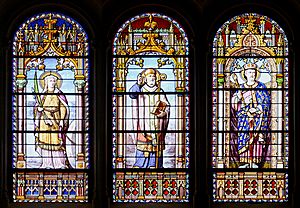Church of Saint Jerome the Royal facts for kids
Quick facts for kids San Jerónimo el Real |
|
|---|---|

View from the north angle
|
|
| Religion | |
| Affiliation | Roman Catholic |
| District | Retiro |
| Region | Community of Madrid |
| Ecclesiastical or organizational status | Parish church |
| Status | Active |
| Location | |
| Municipality | |
| State | Spain |
| Architecture | |
| Architect(s) | Enrique Egas |
| Architectural style | Isabelline Gothic |
| Groundbreaking | 1503 |
| Completed | 1505 |
| Direction of façade | East |
| Designated as NHL | 1925 |
| Website | |
| www.parroquiasanjeronimoelreal.es | |
San Jerónimo el Real (pronounced San Heh-ROH-nee-moh el Reh-AHL) is a beautiful old church in the heart of Madrid, Spain. It was built a long time ago, in the early 1500s! This church is a Roman Catholic place of worship.
Over many years, the church has been changed and fixed up several times. It is the last part of a large monastery that used to be next to a royal palace. Part of that palace is now the famous Prado museum. Because it was so close to the royal palace, the church became very important to the Spanish royal family. For hundreds of years, it was where the Prince of Asturias (the heir to the Spanish throne) was officially recognized. Even King Juan Carlos I had a special ceremony here when he became king. Madrid did not have its main Cathedral of the Almudena until 1993. Before that, the Church of San Isidro was often used as a main church. However, San Isidro was linked to workers, not royalty. So, San Jerónimo el Real became the special church for the royal family.
Contents
The Church's Story
The original monastery, called Monasterio de Santa María del Paso, was first built near the Manzanares river. This was during the time of King Henry IV of Castile. But the land was very wet and made the monks sick. So, in 1502, Queen Isabella I gave the monks new land. They built a new monastery there in a style called Isabelline Gothic. This church was chosen for important royal events. For example, the future King Philip II was officially recognized here on April 18, 1528.
When King Philip II moved the Spanish court to Madrid in 1561, he made his small retreat much bigger. This became the Palacio del Buen Retiro. He even had a special bedroom built next to the church's main altar. This way, he could listen to Mass from his room. Sadly, much of the Palacio del Buen Retiro was destroyed during the French occupation of Madrid. In 1808, the monks had to leave the monastery. French soldiers stayed there, causing a lot of damage. The church was almost completely ruined.
Bringing the Church Back to Life
The church needed a lot of work to be fixed. The first big repair happened between 1848 and 1859. This was during the rule of Queen Isabel II of Spain. An architect named Narciso Pascual Colomer worked on it. He kept the Isabelline Gothic style and added new parts, like towers.
The second major restoration took place from 1879 to 1883. Architect Enrique María Repullés changed the building into the parish church we see today. Only a few parts of the outside are from the original building. The changes made to the outside in the 1800s, in a neo-Gothic style by Pontian Ponzano, are still talked about today.
In 1906, a grand stairway was built facing the street. This was for the wedding of King Alfonso XIII. It made the entrance to the church look much more impressive. For many years, the old Baroque cloister (a covered walkway around a courtyard) was falling apart. Finally, in 2007, the church and the government made an agreement. The land where the cloister stood was given to the Prado Museum. The inner courtyard wall was carefully taken apart and then rebuilt as a cube-shaped room. This new part was designed by Rafael Moneo and is now an expansion of the museum. People often call this new section the Cubo de Moneo, or "Moneo's Cube."
Inside the Church
The inside of San Jerónimo el Real holds many beautiful artworks. You can see sculptures by Mariano Benlliure Gill. There is also an 18th-century sculpture called Cristo de la Buena Muerte by Juan Pascual de Mena. The church also has paintings by Vincenzo Carducci and José Méndez. Look for the special neo-Gothic lamps and the colorful stained-glass windows.
Images for kids
See also
 In Spanish: Iglesia de San Jerónimo el Real para niños
In Spanish: Iglesia de San Jerónimo el Real para niños
- Catholic Church in Spain
- Jerónimos Monastery
- List of oldest church buildings






